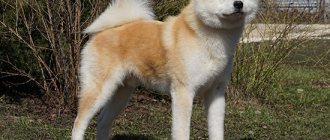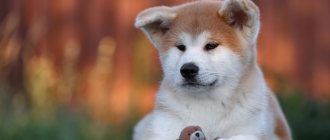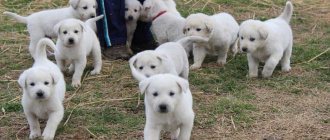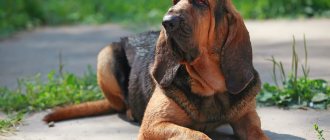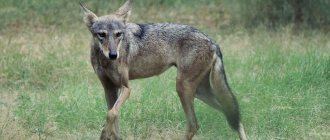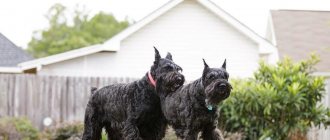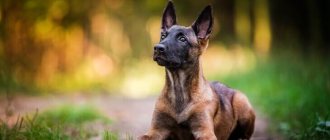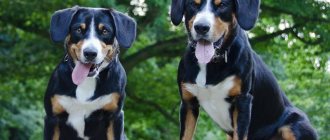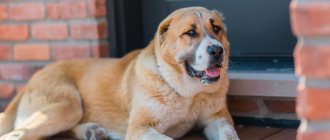Color classifications
There is no consensus in the canine community about the acceptable colors of Akita Inu. The World Canine Organization allows only four:
- brindle;
- snow-white;
- red-fawn;
- sesame.
Other organizations have their own versions. AKIHO accepts the following colors of Japanese Akita:
- white;
- redhead;
- spotted;
- black;
- brindle;
- sesame.
According to NIPPO, there are only 5 variations:
- white;
- black;
- sesame;
- redheads;
- brindle.
AKIKIO allows the following suits of “Japanese huskies”:
- black;
- sesame;
- white;
- ginger;
- brindle.
Another common classification of breed colors:
- "Red Urajiro." “Fox” is red with characteristic white markings on the cheeks, lower jaw, muzzle, neck, chest, abdomen, and inner parts of the legs.
- Solid snow white with black nose.
- Brindle. It is divided into three varieties: shimofuri (silver “tiger”), akatora (red, red tiger), kurotora (black “tiger”).
In the homeland of the breed, Japan, the traditional “fox” color of the Akita is valued.
Permitted Akita colors by the Kennel Association
In nature you can find a huge variety of colors of this dog breed. But, dog handlers have approved only four primary colors. This:
- tiger akita;
- Akita Inu white;
- sesame;
- Akita Inu is red.
But not everything is as simple as it seems at first glance. According to the organization that unites all lovers of this color (AKIHO) in Japan, several more colors have been identified, in addition to the main colors, which are not a defect, a deviation from the norm and are quite acceptable in real life. This:
- Akita Inu black;
- Akita is brown.
As for the association that fights for the conservation of Japanese dog species, abbreviated NIPPO, it allows all the possible options listed above, at the same time, it excludes spotted animals. For them, this Akita color is considered a deviation from the norm and is not within the acceptable range. Such toy Akita Inus are not allowed to exhibitions, which, by the way, are held annually by the organization around the world.
If we talk about another world-famous organization specializing in dogs with Japanese roots, AKIKIO, then their vision of beauty is standard and the scope includes:
- Akita white;
- Akita black;
- sesame;
- redhead;
- brindle akita inu.
But, about everything in more detail.
American Akita white
Exactly like the Japanese, these Akitas are considered the most optimal species, but rarely found in our area. Albino Akita Inu should have an even, uniform color. The presence of any spots, even tiny ones, is unacceptable and is considered a deviation from the norm.
Akita dark
You can only meet the black American Akita . And even here it is impossible to say that it is black as coal. With proper and detailed examination, these Akita colors can be classified as either brindle or dark sesame.
Akita inu brindle color
In our area, animals in this color are considered a curiosity. You will rarely see them on the street, and exhibitions are not full of such creatures. But in their historical homeland, tiger pets are the norm. Moreover, colors are allowed in four main shades:
- gray Akita or otherwise it can be called blue Akita ;
- white with very light stripes;
- black. These Akita colors have practically no edges. They are divided depending on the degree of saturation and the predominance of black.
Redhead
A very common shade. But here it is also worth understanding that too pale or, on the contrary, a red Akita Inu is an undesirable option. But at the same time, Urajiro Akita Inu is very welcome. In this coloring, the main color is red, but the muzzle, paws and chest have white pigmentation.
Black and pepper-and-salt animals are more valuable at international exhibitions.
It is worth noting that the presence of stripes on the head is not considered the norm, and in recent years the final decision was made that without them, animals have a more aesthetically beautiful appearance.
Sesame colors
These colors are the most common and familiar to us. Various variations are acceptable, from pale beige to bright red. The red Akita in this division is not a deviation and is very welcome.
Important! For the Japanese Akita, the presence of a so-called mask on the face is a vice and an undesirable defect, while for the American Akita this color with a mask is considered the norm.
White color
White Akita Inu are still a rarity in Russia. But in their Japanese homeland they are already widespread. This color is the youngest, it was developed only at the beginning of the 20th century. The main feature of snow-white Akitas is the absence of even small marks or spots on the body. A yellow, grayish “patina” on the back and sides is considered a fault. But at the same time, the presence of a bluish, silver “mantle” adds points to the dog at exhibitions. These dogs are not albinos. They have dark eyes, a black or “liver” nose, black lips, “eyeliner” on the eyes - this is a standard requirement. As an exception, a light nose is allowed. But the lips and eyes should be black. White Akitas, according to owners, are more prone to allergic reactions - dogs require special food selected by a veterinarian. One of the manifestations of allergies is the appearance of yellow spots on the dog’s ears, face, and back. Photos of snow-white Akita Inu:
Approved colors
All of the above are united by the fact that no matter what continent the animal lives on and what size it has, there are only four acceptable colors according to the World Canine Federation:
- brindle,
- Sesame,
- Snow-white,
- Red-fawn.
But not everything is so simple! There are three more versions of the standard and they are all presented by different organizations. AKIHO allows the presence of the following colors in the color:
- white,
- spotted,
- black,
- ginger,
- sesame,
- brindle.
NIPPO accepts all of the options listed above, but excludes spotted Akita Inus. AKIKIO allows various options for the following colors:
- Black,
- White,
- brindle,
- Ginger,
- Sesame.
Each author of the listed standards has his own vision of the beauty of the Japanese husky, and he substantiates it with arguments. The difficulty of determining one color or another is also due to the fact that the colors of dogs can change with age. Only the snow-white fur remains unchanged.
Red Akita Inu
Red is the traditional, most common color of the Akita Inu. The color of the “mantle” is allowed from pale beige to almost fiery red. In this case, a white shirtfront, cheeks, bottom of the muzzle, belly, and inner parts of the legs are required. There may be light marks on the neck. Dark “masks” on the face of the “Japanese husky” are unacceptable. But for American Akitas, this feature is not a disadvantage of the breed. The legendary Hachiko was precisely red-fawn in color. Akitas like these are some of the most spectacular, especially the fiery red dogs. Color develops with age - newborn puppies are almost gray and black. From about 3 months, the color begins to change to a permanent one. Photos of red Japanese Akitas:
Red and sesame
This classification includes wool from pale beige to fiery red. The undercoat can also play an important role. For example, a light undercoat visually lightens the guard hair, while against a dark background the color of the coat will look more saturated.
The presence of a “mask” on the face is a serious defect for the Japanese variety, but it is almost always present and is considered the norm in the American type.
The sesame variant is the rarest today and although it is still listed in the standards, it may soon disappear completely, since it does not take part in selection. Until the fifties of the last century, it was a classic - a red fur coat with a dark belt on the back. Now in Japan, individuals with sesame coloring are not popular.
Sesame Akita Inu
This color is becoming rare nowadays, even in the 50s. 20th century was the most common among Akita Inu representatives. This is a red “mantle”, but with a peculiar black “belt” on the back and a snow-white bottom. As for red representatives, the white underside is important here - the chest, belly, inner parts of the paws, tail, cheeks and lower jaw. Everyone sympathizes with Kadyrov’s grief: the sad news shocked people Scandal on Channel One: a famous presenter turned out to be a man who had changed his sex Scientists have discovered a frightening feature in everyone who died from COVID-19: Today, sesame color is practically not involved in selection. In the Japanese homeland of the breed, it is no longer popular; in Russia there are practically no such dogs. Due to the similarity of colors, these representatives of the breed were often called “Japanese Shepherds.” Pictured are sesame Akita Inu:
FCI breed standard No. 255 dated April 2, 2001 Akita Inu
- Dogs
- Dog breeds: all dogs from…✔
- Akita Inu
- FCI breed standard No. 255…✔
COUNTRY OF ORIGIN: Japan PUBLICATION DATE OF ORIGINAL CURRENT STANDARD: 03/13/2001 OFFICIAL SCOPE: Companion dog FCI CLASSIFICATION: Group 5 - Spitz and primitive types of dogs Section 5 - Asian Spitz
No operational tests
BRIEF HISTORICAL SUMMARY: Initially, Japanese dogs were small or medium in size, there were no large breeds. Since 1603, Akita Matagi (medium-sized bear hunting dogs) have been used for dog fighting in Akita County. Since 1868, the Matagi were crossed with Tosa Inu and Mastiffs, as a result of which the size of the breed increased, but the Spitz-type traits disappeared. In 1908, dog fighting was banned, but the breed survived and improved, becoming the Japanese large dog breed. As a result, in 1931, nine outstanding representatives of the breed were named “Natural Monuments”. During World War II (1939 - 1945), dogs were often used as fur for military clothing. By order of the police, all dogs were caught and confiscated, with the exception of German shepherds used in military service. Some fanciers have tried to circumvent this order by breeding their dogs to German Shepherds. By the end of World War II, the number of Akitas had declined sharply. In addition, three distinct intrabreed types have emerged: 1) Matagi Akita; 2) fighting Akitas and 3) herding Akitas. As a result, the situation in the breed turned out to be very complex and confusing. During the restoration of the purebred Akita population after the war, a male from the Dewa line named Kongo-go, whose exterior was influenced by both mastiffs and German shepherds, gained short-term but significant popularity. However, reasonable and educated breed lovers did not consider him to be a type of true Japanese breed, so they made efforts to eliminate the influence of foreign breeds and restore the original pure breed by breeding with Matagi Akita. They managed to obtain a stable population of large Japanese breed dogs, in the form for which they are known today.
GENERAL APPEARANCE: Large dog, well balanced, powerful and solid build: secondary sexual characteristics are strongly expressed; the dog has a noble appearance, has modesty and self-esteem; strong type of constitution.
IMPORTANT PROPORTIONS: The ratio of the height at the withers to the length of the body (from the shoulder protuberance to the ischial tuberosity) is 10:11, while the body of females is longer than that of males.
BEHAVIOR AND TEMPERAMENT: Discreet, loyal, obedient and receptive character.
HEAD: CRANIAL REGION: Skull: Size proportional to body. The forehead is wide, with a distinct hollow in the middle. No wrinkles. Stop (transition from forehead to muzzle): Pronounced.
FACIAL REGION: Nose: Large and black. Minor scattered depigmentation is allowed only with a white coat, with a black nose being preferred. Muzzle: Moderately long, powerful, broad-based, tapering towards the nose, but not pointed. The bridge of the nose is straight. Jaws/teeth: Powerful teeth, scissor bite. Lips: Tight fitting. Cheeks: Moderately developed. Eyes: Relatively small, raised outer corners give them an almost triangular shape, moderately spaced, dark brown: the darker the better. Ears: Relatively small, thick, triangular in shape with slightly rounded tips, moderately spaced, erect, inclined forward.
NECK: Thick and muscular, without dewlap, in proportion to the head.
BODY: Back: Straight and strong. Loin: Wide and muscular. Chest: Deep, well developed in front, ribs moderately sprung. Belly: Well tucked
TAIL: Set high, thick, carried vigorously over the back; when lowered, the tip of the tail almost reaches the hock joints.
LIMBS: FOREQUARTERS: Straight, heavy boned. Shoulder: Moderately sloping, developed. Elbows: Tightly pressed to the body.
HINDQUARTERS: Well developed, powerful, moderately angulated. FEET: Thick, round, arched, well balled.
MOVEMENT: Elastic, powerful.
COAT: Coat: the outer coat is hard and straight, the undercoat is soft and dense; the hair on the withers and rump is somewhat longer; The hair on the tail is longer than on the body. Color: Red-fawn, sesame (red-fawn hair with black tips), brindle and white. With all of the above colors, with the exception of white, the dog must have “Urajiro” (Urajiro is whitish hair on the sides of the muzzle, on the cheekbones, the lower surface of the jaw, on the neck, chest, body and tail, as well as on the inner surfaces of the legs).
SIZE: Height at withers:
- Male: 67 cm
- Female: 61 cm
Deviation from the above dimensions is allowed no more than 3 cm in any direction.
FAULTS: Any deviation from the above requirements is considered a fault and its severity is assessed strictly in proportion to its severity.
- Deviation from the sexual type (male in the bitch type or bitch in the male type)
- Overshot or undershot
- Missing teeth
- Tongue with blue or black spots
- Lightened iris of the eye
- Short tail
- Timidity
DISQUALIFYING FAULTS:
- Erect ears
- Hanging tail
- Long hair (shaggy)
- Black mask
- Markings on a white background
NB: Males must have two normal, fully descended testicles.
